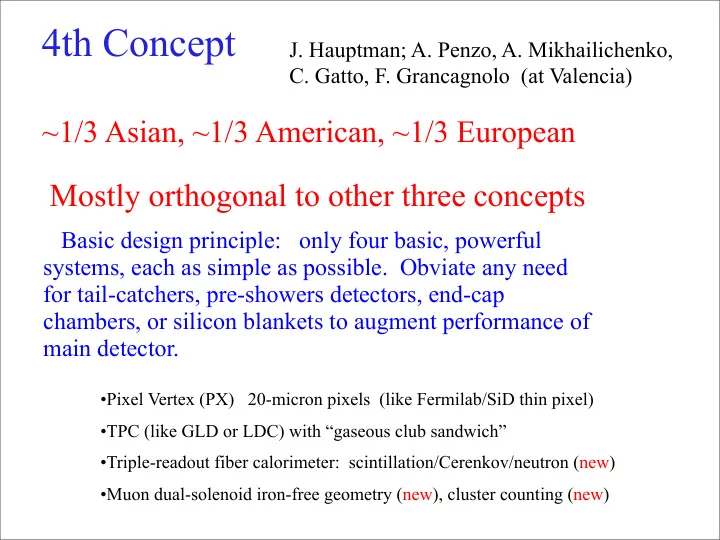

4th Concept J. Hauptman; A. Penzo, A. Mikhailichenko, C. Gatto, F. Grancagnolo (at Valencia) ~1/3 Asian, ~1/3 American, ~1/3 European Mostly orthogonal to other three concepts Basic design principle: only four basic, powerful • basic design systems, each as simple as possible. Obviate any need • B for tail-catchers, pre-showers detectors, end-cap chambers, or silicon blankets to augment performance of main detector. •Pixel Vertex (PX) 20-micron pixels (like Fermilab/SiD thin pixel) •TPC (like GLD or LDC) with “gaseous club sandwich” •Triple-readout fiber calorimeter: scintillation/Cerenkov/neutron (new) •Muon dual-solenoid iron-free geometry (new), cluster counting (new)
Patrick Le Du DAPNIA/SPP , 91191 GIF sur Yvette, France Daniele Barbareschi, Emanuela Cavallo, Vito Di Benedetto, Corrado Gatto, Franco Grancagnolo, Fedor Ignatov, Anna Mazzacane, Giovanni Tassielli, Giuseppina Terracciano INFN and Dipartimento di Fisica , via Lecce-Arnesano, 73100, Lecce, Italy Antonino Lamberto 1 , Aldo Penzo, Gaetana Francesca Rappazzo 1 INFN, Trieste, Padriciano 99; I-34012 Padriciano, Trieste, Italy Giovanni Pauletta 2 University di Udine , 33100 Udine, Italy Sunghwan Ahn, Tae Jeong Kim, Kyong Sei Lee, Sung Keun Park Department of Physics, Korea University , Seoul 136-701, Korea T. Wu a , C.C. Xu a , Z.B. Yin a , D.C. Zhou a , G.M. Huang a , Y.Z. Lin b a Institute of Particle Physics, Huazhong Normal University , Wuhan 430079 China b Huazhong University of Science and Technology , Wuhan, China Sorina Popescu 3 , Laura Radulescu 3 IFIN-HH, Bucharest, Romania Sezen Sekmen, Efe Yazgan 2 , Mehmet Zeyrek Physics Department, Middle East Technical University , Ankara, Turkey S.I. Bondarenko, A.N. Omeliyanchuk, A.A. Shablo, N.S. Scherbakova, N.M. Levchenko Institute for Low temperature Physics and Engineering , Kharkov, Ukraine Alexander Mikhailichenko Cornell University , Ithaca, NY 14853-5001 USA Muzaffer Atac, Marcel Demarteau, Ingrid Fang, Stephen R. Hahn, Caroline Milstene, Robert Wands, Ryuji Yamada, G.P. Yeh Fermi National Accelerator Laboratory, Batavia, IL 60510 USA Oleksiy Atramentov, Anatoli Frishman, John Hauptman, Jerry Lamsa, Sehwook Lee, Jason Murphy, Norio Nakagawa, German Valencia Department of Physics and Astronomy, Iowa State University, Ames, IA 50011 USA Michael Gold, John Matthews, John Strologas 2 , Marcelo Vogel 2 Department of Physics, University of New Mexico, Albuquerque, NM 87131 USA Nural Akchurin, Heejong Kim, Sungwon Lee, Mario Spezziga 3 , Igor Volobouev, Richard Wigmans Department of Physics, Texas Tech University Lubbock, TX 79409-3783 USA
4th talks at Valencia Workshop • Alexander Mikhailichenko , Cornell LNS, machine-detector interface, push-pull, B-field configuration • Aldo Penzo, INFN Trieste, dual readout calorimetry and its extensions • Franco Grancagnolo, INFN Lecce, muon spectrometer • Corrado Gatto, INFN Lecce, ILCroot simulation and analysis of 4th Concept
A. Mikhailichenko Dual solenoids Final focus optics, mounted inside a Directional kicker cylinder attached to the detector by consoles. This reduces influence of ground motion. Valves for push-pull FF optics disconnection
New magnetic field, new ``wall of coils’’, iron-free: many benefits to muon detection and MDI, Alexander Mikhailichenko design
Aldo Penzo : DREAM module: simple, robust, not intended to be “best” at anything, just test dual-readout principle Back end of 2-meter deep module Physical channel structure Unit cell
Downstream end of DREAM module, showing HV and signal connectors
Dual-Readout: Measure every shower twice - in 200 GeV “jets” scintillation light and in Cerenkov light. ( e/h ) C = η C ≈ 5 ( e/h ) S = η S ≈ 1 . 4 C = [ f em + (1 − f em ) / η C ] E S = [ f em + (1 − f em ) / η S ] E → C/E = 1 / η C + f em (1 − 1 / η C ) Data NIM A537 (2005) 537.
DREAM data 200 GeV π - : Energy response Scintillating fibers Scint + Cerenkov f EM ∝ (C/E shower - 1/ η C ) (4% leakage fluctuations) Scint + Cerenkov f EM ∝ (C/E beam - 1/ η C ) (suppresses leakage) Data NIM A537 (2005) 537.
More important than good Gaussian response: DREAM module calibrated with 40 GeV e - into the centers of each tower responds linearly to π - and “jets” from 20 to 300 GeV. e - Hadronic linearity may be the most important achievement of dual- readout calorimetry. Data NIM A537 (2005) 537.
ILC-type module DREAM module 2mm Pb or brass plates; fibers every 2 mm 3 scintillating fibers (Removes correlated fiber hits) 4 Cerenkov fibers → “Unit cell”
Binding energy loss fluctuations: next largest hadronic shower fluctuation after EM fraction, correlated with MeV neutrons (1) Measure MeV neutrons by time. ~~~~~~~~~~~~~~ Pathlength (cm) Velocity of MeV neutrons is ~ 0.05 c (protons) (1) Scintillation light from np → np scatters comes late; and, (2) neutrons fill a larger (neutrons) volume t(ns) →
Franco Grancagnolo : Muon spectrometer
4th Concept Muon Tracking Field Dual solenoid tracking along muon trajectories in the annulus between solenoids
Dual readout of muons in DREAM module π ± rejection: 10 − 3 at 20 GeV 10 − 4 at 200 GeV
Corrado Gatto: ILCroot e + e − → H 0 Z 0 → W + W − µ + µ − → jj e − ν µ + µ − Text Text Text Text Text Text Text Text Illustrates all the detectors of 4 th Concept … particle ID “obvious”
Recommend
More recommend